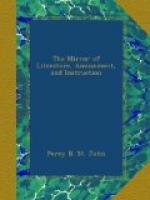Boring Marine Animals.
The most destructive of these is the Teredo Navalis, a fine specimen of which was exhibited at a recent meeting of the Portsmouth Philosophical Society. This animal has been said to extend the whole length of the boring tube; but this assertion is erroneous, since the tubes are formed by a secretion from the body of the animal, and are often many feet in length, and circuitous in their course. This was shown to be the fact, by a large piece of wood pierced in all directions. The manner in which it affects its passage, and the interior of the tubes, were also described. The assertion that the Teredo does not attack teak timber was disproved; and its destructive ravages on the bottom of ships exemplified, by a relation of the providential escape of his majesty’s ship Sceptre, which having lost some copper from off her bows, the timbers were pierced through to such an extent as to render her incapable of pursuing her voyage without repair.
Anthracite, or Stone Coal.
Professor Silliman’s last journal contains a very important article, illustrative of the practical application of this mineral; and the vast quantities of it that may be found in Great Britain renders the information highly valuable to our manufacturing interests. In no part of the world is anthracite, so valuable in the arts and for economical purposes, found so abundantly as in Pennsylvania. For the manufacture of iron this fuel is peculiarly advantageous, as it embraces little sulphur or other injurious ingredients; produces an intense steady heat; and, for most operations, it is equal, if not superior to coke. Bar iron, anchors, chains, steamboat machinery, and wrought-iron of every description, has more tenacity and malleability, with less waste of metal, when fabricated by anthracite, than by the aid of bituminous coal or charcoal, with a diminution of fifty per cent. in the expense of labour and fuel. For breweries, distilleries, and the raising of steam, anthracite coal is decidedly preferable to other fuel, the heat being more steady and manageable, and the boilers less corroded by sulphureous acid, while no bad effects are produced by smoke and bitumen. The anthracite of Pennsylvania is located between the Blue Bridge and Susquehannah; and has not hitherto been found in other parts of the state, except in the valley of Wyoming.
Holly Hedges.




